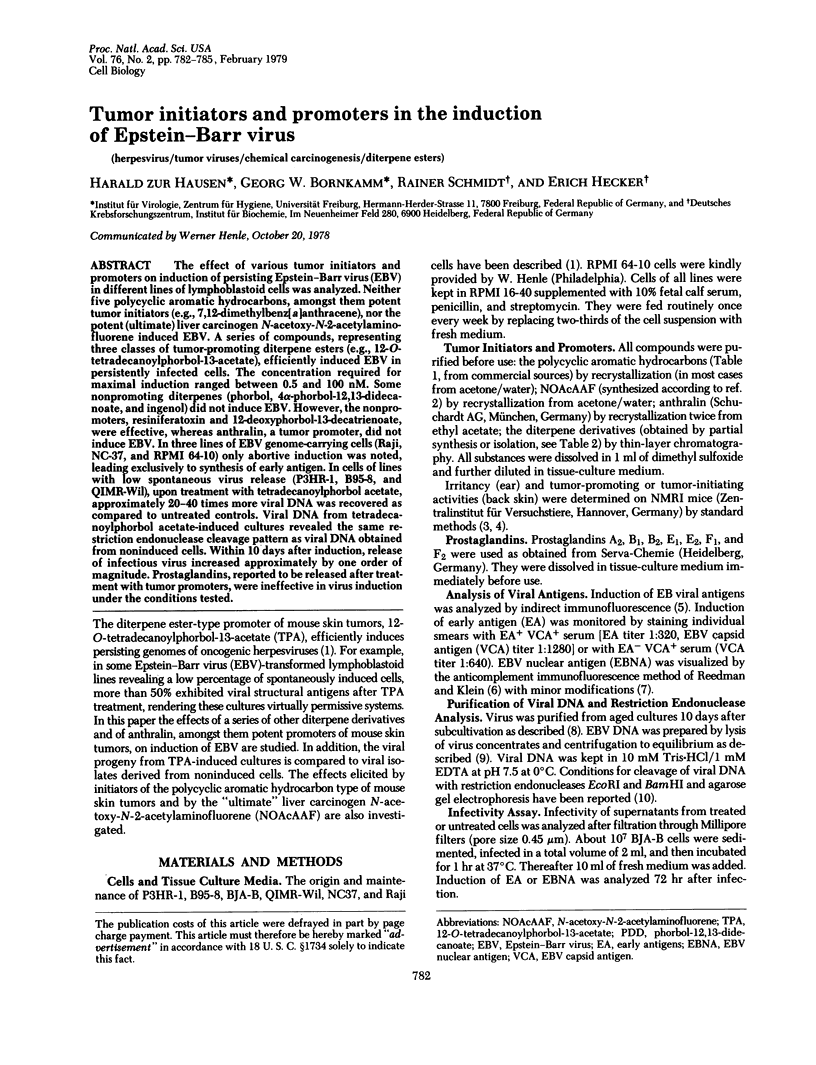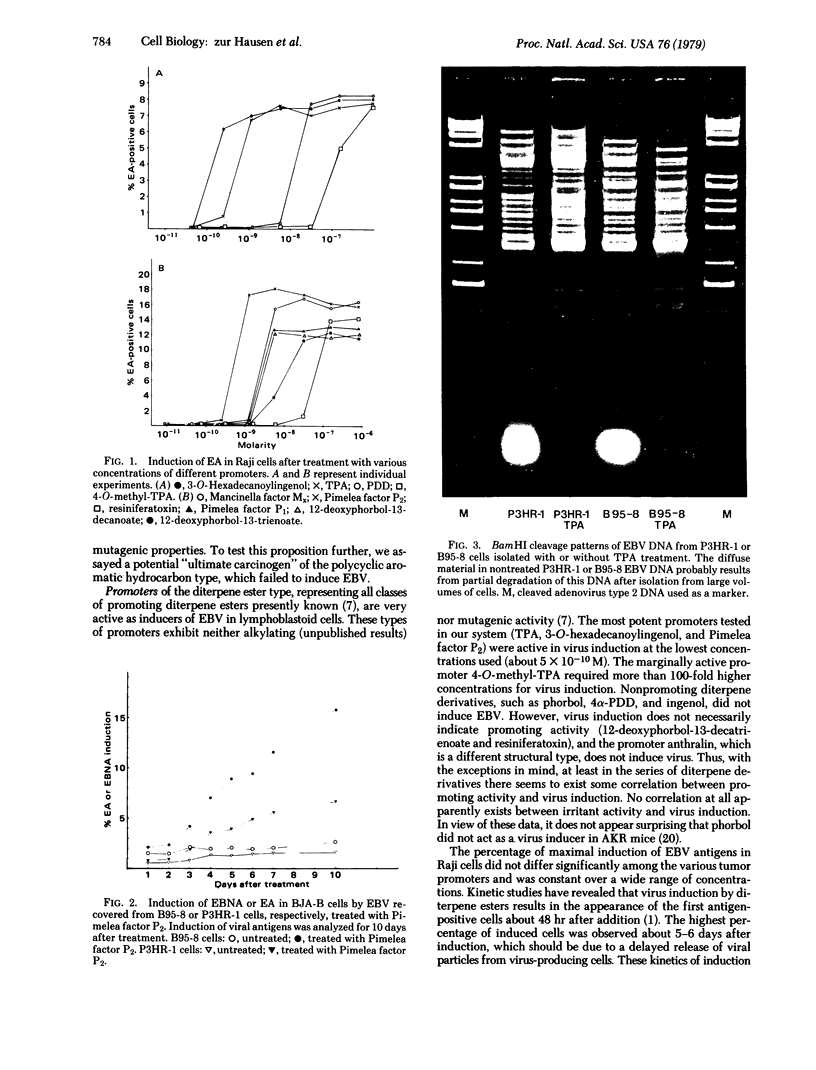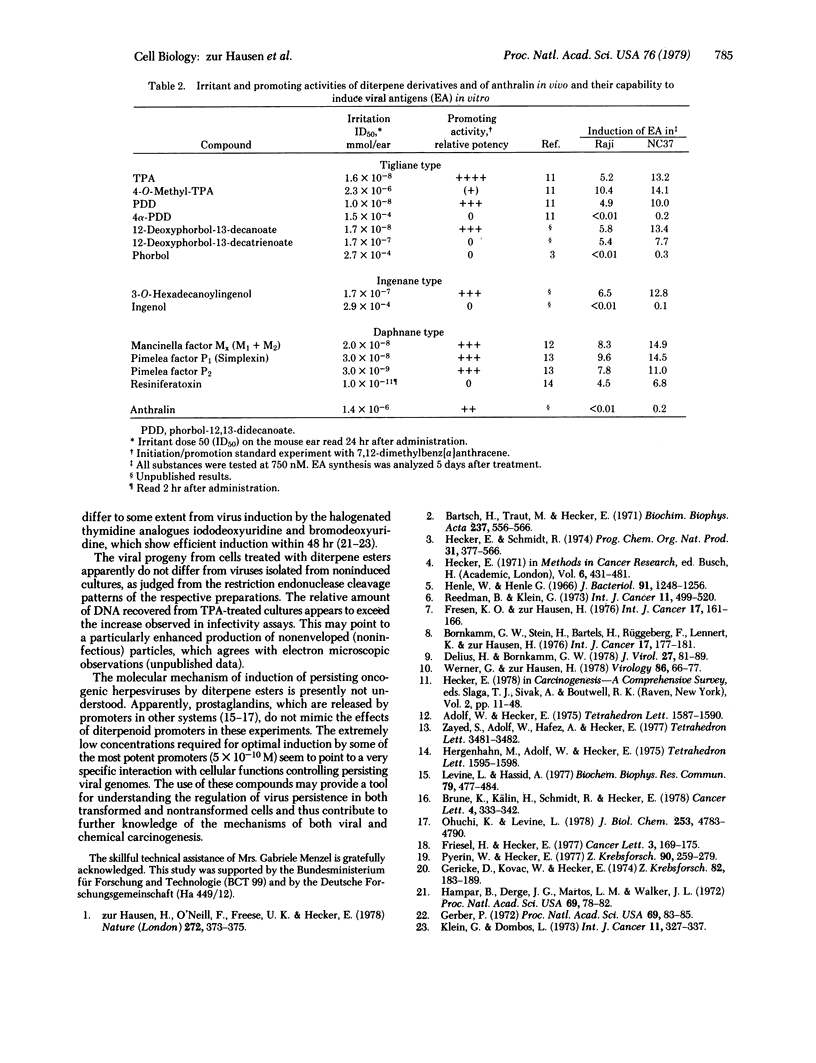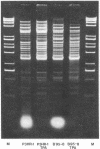Abstract
The effect of various tumor initiators and promoters on induction of persisting Epstein-Barr virus (EBV) in different lines of lymphoblastoid cells was analyzed. Neither five polycyclic aromatic hydrocarbons, amongst them potent tumor initiators (e.g., 7,12-dimethylbenz[a]anthracene), nor the potent (ultimate) liver carcinogen N-acetoxy-N-2-acetylamino-fluorene induced EBV. A series of compounds, representing three classes of tumor-promoting diterpene esters (e.g., 12-O-tetradecanoylphorbol-13-acetate), efficiently induced EBV in persistently infected cells. The concentration required for maximal induction ranged between 0.5 and 100 nM. Some nonpromoting diterpenes (phorbol, 4α-phorbol-12,13-didecanoate, and ingenol) did not induce EBV. However, the nonpromoters, resiniferatoxin and 12-deoxyphorbol-13-decatrienoate, were effective, whereas anthralin, a tumor promoter, did not induce EBV. In three lines of EBV genome-carrying cells (Raji, NC-37, and RPMI 64-10) only abortive induction was noted, leading exclusively to synthesis of early antigen. In cells of lines with low spontaneous virus release (P3HR-1, B95-8, and QIMR-Wil), upon treatment with tetradecanoylphorbol acetate, approximately 20-40 times more viral DNA was recovered as compared to untreated controls. Viral DNA from tetradeca-noylphorbol acetate-induced cultures revealed the same restriction endonuclease cleavage pattern as viral DNA obtained from noninduced cells. Within 10 days after induction, release of infectious virus increased approximately by one order of magnitude. Prostaglandins, reported to be released after treatment with tumor promoters, were ineffective in virus induction under the conditions tested.
Keywords: herpesvirus, tumor viruses, chemical carcinogenesis, diterpene esters
Full text
PDF



Images in this article
Selected References
These references are in PubMed. This may not be the complete list of references from this article.
- Bartsch H., Traut M., Hecker E. On the metabolic activation of N-hydroxy-N-2-acetylamino-fluorene. II. Simultaneous formation of 2-nitrosofluorene and N-acetoxy-N-2-acetylaminofluorene from N-hydroxy-N-2-acetylaminofluorene via a free radical intermediate. Biochim Biophys Acta. 1971 Jun 22;237(3):556–566. doi: 10.1016/0304-4165(71)90276-5. [DOI] [PubMed] [Google Scholar]
- Bornkamm G. W., Stein H., Lennert K., Rüggeberg F., Bartels H., zur Hausen H. Attempts to demonstrate virus-specific sequences in human tumors. IV. EB viral DNA in European Burkitt lymphoma and immunoblastic lymphadenopathy with excessive plasmacytosis. Int J Cancer. 1976 Feb 15;17(2):177–181. doi: 10.1002/ijc.2910170205. [DOI] [PubMed] [Google Scholar]
- Delius H., Bornkamm G. W. Heterogeneity of Epstein-Barr virus. III. Comparison of a transforming and a nontransforming virus by partial denaturation mapping of their DNAs. J Virol. 1978 Jul;27(1):81–89. doi: 10.1128/jvi.27.1.81-89.1978. [DOI] [PMC free article] [PubMed] [Google Scholar]
- Fresen K. O., Hausen H. Establishment of EBNA-expressing cell lines by infection of Epstein-Barr virus (EBV)-genome-negative human lymphoma cells with different EBV strains. Int J Cancer. 1976 Feb 15;17(2):161–166. doi: 10.1002/ijc.2910170203. [DOI] [PubMed] [Google Scholar]
- Friesel H., Hecker E. Reaction of arene oxides with nucleosides. Cancer Lett. 1977 Sep;3(3-4):169–175. doi: 10.1016/s0304-3835(77)95370-8. [DOI] [PubMed] [Google Scholar]
- Gerber P. Activation of Epstein-Barr virus by 5-bromodeoxyuridine in "virus-free" human cells (complement-fixing antigen-immunofluorescence-leukocytes). Proc Natl Acad Sci U S A. 1972 Jan;69(1):83–85. doi: 10.1073/pnas.69.1.83. [DOI] [PMC free article] [PubMed] [Google Scholar]
- Gericke D., Kovac W., Hecker E. On a possible cocarcinogenic and immunosuppressive activity of phorbol in AKR-mice. Z Krebsforsch Klin Onkol Cancer Res Clin Oncol. 1974;82(3):183–189. doi: 10.1007/BF00304057. [DOI] [PubMed] [Google Scholar]
- Hecker E., Schmidt R. Phorbolesters--the irritants and cocarcinogens of Croton Tiglium L. Fortschr Chem Org Naturst. 1974;31(0):377–467. doi: 10.1007/978-3-7091-7094-6_7. [DOI] [PubMed] [Google Scholar]
- Henle G., Henle W. Immunofluorescence in cells derived from Burkitt's lymphoma. J Bacteriol. 1966 Mar;91(3):1248–1256. doi: 10.1128/jb.91.3.1248-1256.1966. [DOI] [PMC free article] [PubMed] [Google Scholar]
- Klein G., Dombos L. Relationship between the sensitivity of EBV-carrying lymphoblastoid lines to superinfection and the inducibility of the resident viral genome. Int J Cancer. 1973 Mar 15;11(2):327–337. doi: 10.1002/ijc.2910110210. [DOI] [PubMed] [Google Scholar]
- Levine L., Hassid A. Effects of phorbol-12,13-diesters on prostaglandin production and phospholipase activity in canine kidney (MDCK) cells. Biochem Biophys Res Commun. 1977 Nov 21;79(2):477–484. doi: 10.1016/0006-291x(77)90182-6. [DOI] [PubMed] [Google Scholar]
- Ohuchi K., Levine L. Stimulation of prostaglandin synthesis by tumor-promoting phorbol-12, 13-diesters in canine kidney (MDCK) cells. Cycloheximide inhibits the stimulated prostaglandin synthesis, deacylation of lipids, and morphological changes. J Biol Chem. 1978 Jul 10;253(13):4783–4790. [PubMed] [Google Scholar]
- Pyerin W. G., Hecker E. On the biochemical mechanism of tumorigenesis in mouse skin. VIII. Isolation and characterization of epidermal microsomes and properties of their arylhydrocarbon monooxygenase and epoxide hydr(at)ase. Z Krebsforsch Klin Onkol Cancer Res Clin Oncol. 1977 Dec 15;90(3):259–279. doi: 10.1007/BF00284300. [DOI] [PubMed] [Google Scholar]
- Reedman B. M., Klein G. Cellular localization of an Epstein-Barr virus (EBV)-associated complement-fixing antigen in producer and non-producer lymphoblastoid cell lines. Int J Cancer. 1973 May;11(3):499–520. doi: 10.1002/ijc.2910110302. [DOI] [PubMed] [Google Scholar]
- Werner G., zur Hausen H. Deletions and insertions in adenovirus type 12 DNA after viral replication in Vero cells. Virology. 1978 May 1;86(1):66–77. doi: 10.1016/0042-6822(78)90008-9. [DOI] [PubMed] [Google Scholar]
- zur Hausen H., O'Neill F. J., Freese U. K., Hecker E. Persisting oncogenic herpesvirus induced by the tumour promotor TPA. Nature. 1978 Mar 23;272(5651):373–375. doi: 10.1038/272373a0. [DOI] [PubMed] [Google Scholar]



